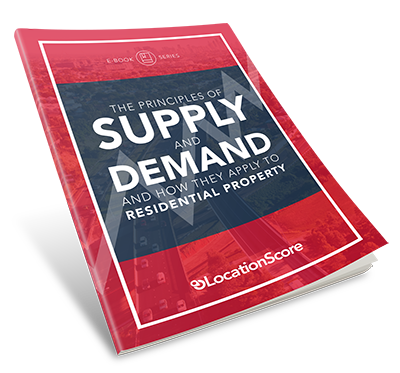×

The Principles of Supply and Demand and How They Apply to Residential Property
We Only Send You Awesome Stuff

LocationScore
|
June 7, 2017
Ben: LocationScore lads here, talking about Stock on Market or, more precisely, the percentage of stock on market. So Bryce, what's Stock on Market?
Bryce: Well mate, this would be a favorite of yours wouldn’t it? Because this is ultimately the measure of supply in the market! If you've got more properties available on the market than there are buyers, well, that's the enemy of capital growth, isn’t it?
Jeremy: You stole my thunder! Yeah, supply is the absolute enemy of property investors, which will kill capital growth like nothing else does. So it's a really important indicator. And it's not about the number of properties; it's about the percentage of the properties in the market. So you could have a very large market with ten thousand houses—and if you've only got ten of them that are available for sale, then that is a very low percentage of stock market. And the reverse could be true: you could have ten in a market where there's only a hundred properties, and that would be ten percent. I mean, I don't know if there is a market that small, but—
Bryce: So when you started this research, was this the indicator that kicked it off for you? Because ultimately, on the supply side, it's really the fundamental one.
Jeremy: Yeah, it is. There are a lot of people who focus on demand—and what I've noticed is that it seems to be the chronic shortage of supply that has a greater impact than the high demand. I guess what you find is that there are markets that appeal to developers because they're in the news about infrastructure projects going on. And these are all focused on what drives demand, what makes the location appealing to buyers and to tenants, but, really, the markets that seem to have the greatest capital growth are the ones that have, perhaps, moderate demand, or at least sufficient, and just chronic under supply. You don't hear about them, and this is a great indicator for uncovering them.
Bryce: Yeah it's a good point isn't it? Because a lot of people get seduced by, “There’s people going over there in droves, we must go there, to follow the people!” But it's so much more than that.
Ben: It is so much more. I think what we're trying to talk about here is, what is the trend line doing—so what's actually happening?—the stock on market is actually coming down as opposed to going up. So keeping it very simple. We’re tracking and scoring the percentage of stock on market. And the lower the percentage goes, over time—because each market is being measured on a monthly basis as part of the scoring that we're doing—it's really important to understand as it's starting to get smaller and smaller as a percentage … that's actually a good news story for us in regards to potential capital growth.
Jeremy: Yeah. I mean; you can picture these sorts of markets—where you've got an enormous number of people turning up to an open inspection because they've been waiting for weeks and weeks, maybe months, for another property to come on the market. It's when those markets are limited in the stock that they've got, that's of appeal to investors because of the pressure on prices to grow. So, capital growth: it is completely dependent on supply and demand. And you can't just ignore supply.
Bryce: I mean, I said it’s the ‘coalface’—you know, that very thing where we target properties and suburbs that we know has that demand, and then we know there's three or four buyers, and there's only one property that comes up. We actually see that, just by its sheer competition—that person doesn't want to miss it, that person doesn't want to miss it; there's not many around so we're going to put our best foot forward. And in a low interest rate environment we've seen that even more.
Ben: I agree. I think if you actually look at the fundamentals; what we're talking about is that parcel of land has been utilized. Because when we talk about out of city areas—green-field areas, new estates—there can be supply that's turned “on” in terms of new lots of land for sale. When we get closer into some of the areas that are fully utilised … how do we create new supply in those areas? Well, we can knock down a couple of houses and build medium and high-density accommodation, or we can knock down a house and build two. So this is where you can potentially get caught, in regards to some large amount of supply coming online, through a re-zoning from low density to medium or high density in certain main roads, and so forth. That's what you've got to be careful of in terms of some future supply. In this case, we're measuring the current level of supply at that market, aren’t we?
Jeremy: Yeah, yeah—
Bryce: Is it easy enough to get the data?
Jeremy: It is. There are complexities about the base count—how many houses are there, how many units are there in this market, and what's available. So, let's say you're looking at a unit market as listed for sale and there are only three units; a one-bedroom, a two-bedroom, and a three-bedroom, all in the same complex. To me, that is typical of a developer releasing a big block and they've just got one sample of a one-bedroom, a two-bedroom and a three-bedroom. But really, there could be a hundred in the block, so you've only got a count of three, when really there should be a count of a hundred. Yes, so sometimes the statistic can get anomalous, particularly in your markets like that.
There's also issues about the number of properties to begin with—where do you get that data from? Some of it can be based on census data, which can get out of date because it's only sampled every five years. So it can be a little bit volatile and, as Ben mentioned, you probably want to look at a historical chart to see what the line of best fit is, rather looking at individual figures from month to month because it can be volatile.
Bryce: So it’d be fair to say there’s a fair bit of ‘weighting’ in this particular indicator figure for you?
Bryce: Well, a fair bit of ‘weighting’ in your algorithm?
Jeremy: Yes, that's right. When you're combining indicators, and you do need to look at multiple indicators, this one features very prominently because it is straight-up-and-down supply.
Ben: So there you have it. Percentage of stock on market is a really important indicator as part of LocationScore.
Note: This is just a brief explanation on Stock on Market. If you are interested to learn how you can apply this in your own research, our upcoming webinar will unpack this in more details. Learn more about our webinar here.
Most Popular Blog Posts